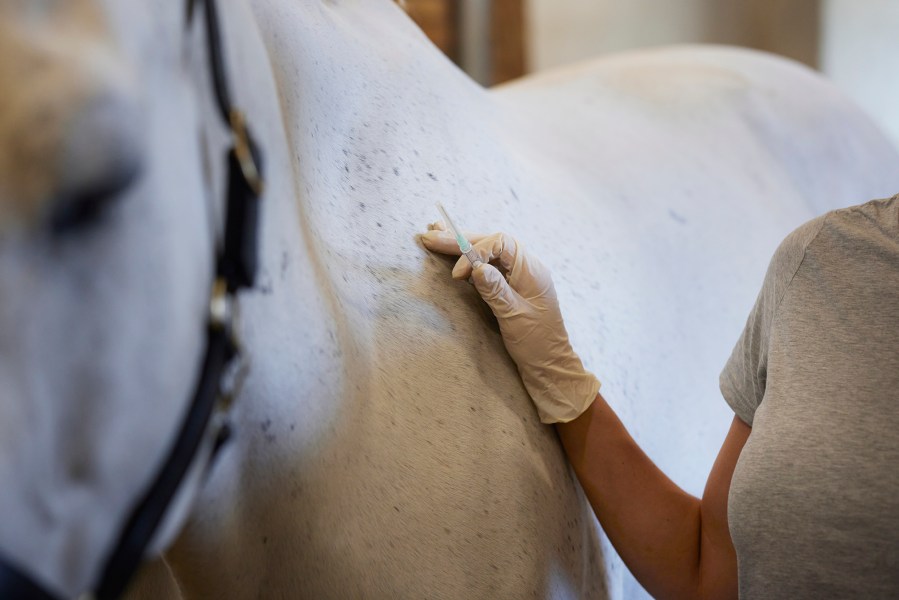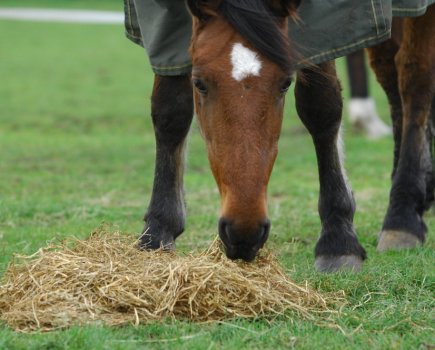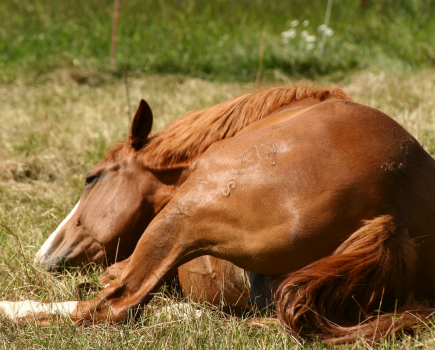Strangles is an extremely contagious illness in horses that affects their upper respiratory tract. It is caused by a bacterium called Streptococcus equi and is the most common equine infectious disease affecting horse health around the world.
Any horse can get strangles, whatever their age, breed, health or value, and it is a horrible disease. However, we now have access to a new safe and effective strangles vaccine that is easy to administer into the muscle, just like many other horse vaccines.
Strangles in horses
As well as curtailing riding activities and the movement of horses, strangles can lead to serious economic loss for yard owners and horse owners, as yard are shut down for long periods.
For affected horses, strangles can cause suffering and in the most severe cases the complications can be life changing. In rare cases, horses can die.
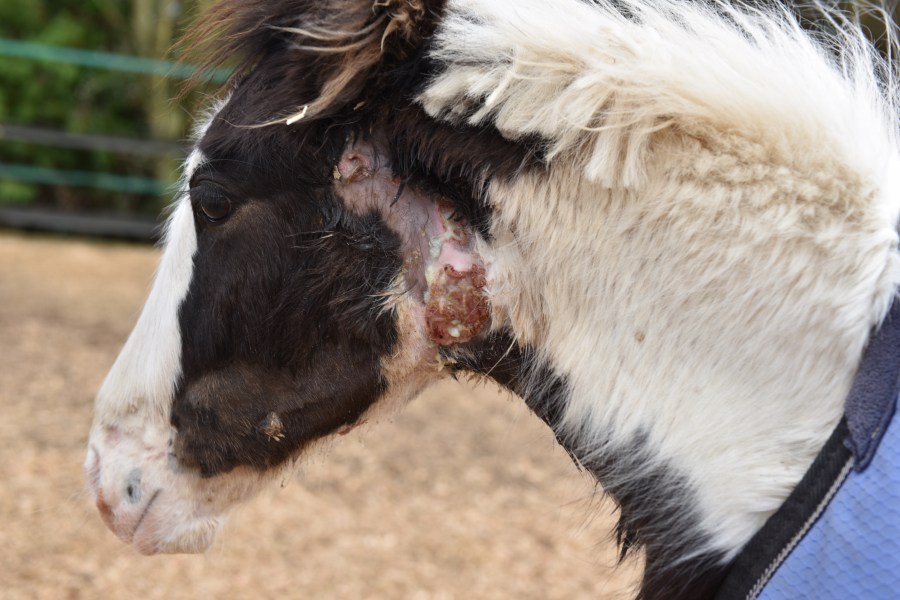
Open abscesses caused by strangles. Credit: Redwings
Quite rightly, there is a lot of concern and worry around strangles in horses.
I regularly get asked for information on infectious diseases, such as strangles, as part of my day-to-day role as a vet.
This article is an overview of what to look out for and how to manage and prevent this highly contagious disease, which is feared by the equestrian industry — and not without good reason.
The strangles vaccine
The strangles vaccine offers owners a further layer of protection to prevent their horse falling ill with strangles, something which can sadly still happen despite having good biosecurity on a yard.
Vaccination primes a horse’s immunity to better fight off the infection if they are exposed to strangles. Most of us want to go out and about with our horses, so strangles is still a threat, especially if infectious horses are also on the move.
The biggest problem with a strangles outbreak is the rapid spread of the disease.
Most of the time I spend talking to clients is really focusing on answering one question: ‘How do I stop my horse from getting strangles?’.
Fortunately, the way strangles is spread — and the fact that the bacterium causing the disease is easily killed — means that prevention is entirely achievable by developing good biosecurity habits.
Transmission routes
Did you know that strangles can survive longer in cold and wet conditions (up to 34 days)?
Strangles in horses is a very transmissible disease and is generally spread via direct or indirect contact between horses. Direct contact between horses is when they touch each other.
Indirect contact is where infective material containing the bacterium that causes strangles ends up being passed on via any of the following:
- People (their hands and clothing)
- Equipment (your tack, grooming brushes, mucking out tools, etc)
- The environment (water troughs, feed bowls, grazing, stable doors and fences)
In these cases, the bacterium reaches the next horse when they lick or touch an infected surface, or eat or drink from an infected source. Suddenly you can see how easy it is for this highly contagious disease to spread.
Signs of strangles in horses
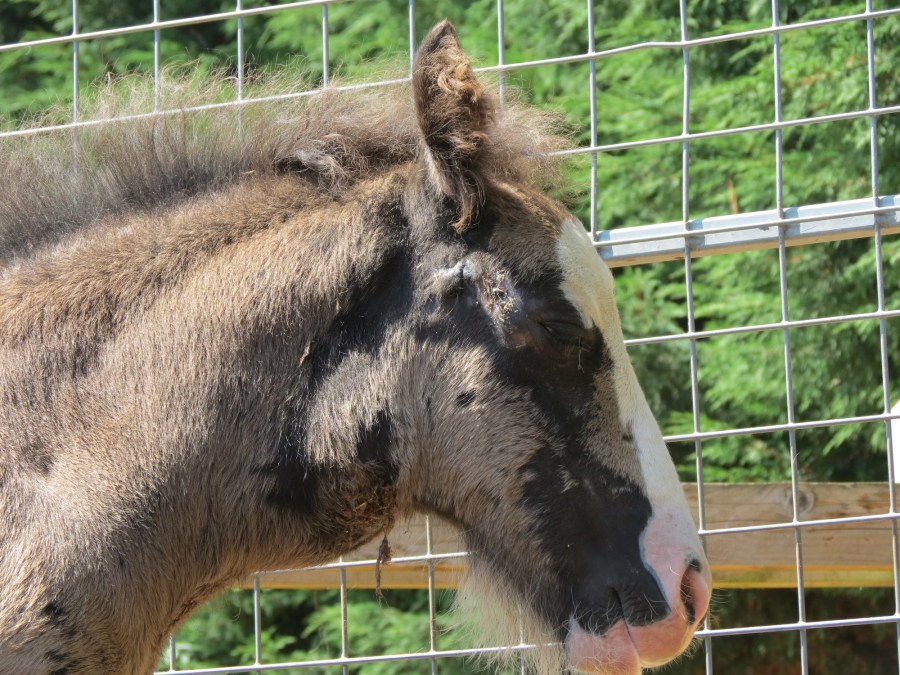
This strangles patient has clear swelling around the throat. Credit: Redwings
It can take as few as two days and up to 21 days for a newly infected horse to show signs of illness after being infected with strangles.
Several factors can influence this.
The earliest signs of strangles in horses are usually fever (an increase of 0.5 °C or more above the normal temperature for that individual) and being off-colour, which is why regular temperature checks are important.
Other signs of strangles in horses include:
- Dullness and depression associated with fever and the swelling of lymph glands around the throat and jaws
- Swollen lymph nodes around the horse’s head
- Trouble swallowing and loss of appetite (due to swelling of the lymph nodes)
- Difficulty breathing (hence the name ‘strangles’)
- Difficulty swallowing
- Thick nasal discharge
- Abscesses on lymph nodes
- A cough
Some horses only show mild signs of disease, such as a briefly raised temperature and loss of appetite or slight nasal discharge.
However, these horses are still infectious and may be completely overlooked, especially if a cough is heard. In rare cases, more prolonged and serious complications can occur as a consequence of the infection.
Video: devastating effects of strangles
Ivesley Equestrian in County Durham was hit by a strangles outbreak in 2023. In the following video, Kath — one of the livery owners — tells her story about the devastating effect strangles had on her horse, Argento:
Complications of strangles in horses
Most horses recover fully from strangles, but occasionally (in about 1% of cases) strangles develops as abscesses forming in lymph nodes elsewhere in the body.
When this happens, it results in prolonged disease often with a very poor outcome despite extensive treatment. This is a condition referred to as ‘bastard strangles’, for literal reasons. Horses may not show signs of it until months after the initial infection.
Other recognised complications include purpura haemorrhagica, which horse owners will recognise as limb swelling, often with little red spots visible over the gums inside the mouth.
This is because the immune system within the horse’s body has activated in response to the infection, and may allow the blood vessels to leak.
Perhaps the most significant complication is the one where the patient is blissfully unaware of anything wrong. These are the horses that become long term carriers of strangles.
Is your horse a carrier?
The riskiest factor in the spread of strangles is that horses will recover visibly but still be infectious to other horses for weeks, months or even years.
In about 10% of cases, the horses can remain infectious by becoming carriers. They show few or no signs of the disease, but pass it on through contact with other horses, the people who touch them, or occasional coughs onto grass, fences or drinking water.
Research has also shown that new outbreaks are more likely to start from direct or indirect contact with recently recovered horses, before they’d have the chance to become the really long term carriers.
So testing all horses on a yard after there has been an outbreak is vital to stop those who take longer to recover from starting the next outbreak of strangles.
The fact horses can return to normal activity and therefore go out to events and mix with new horses, but still have strangles in their airways, makes it doubly important for screening at the end of an outbreak.
What to do if you suspect strangles
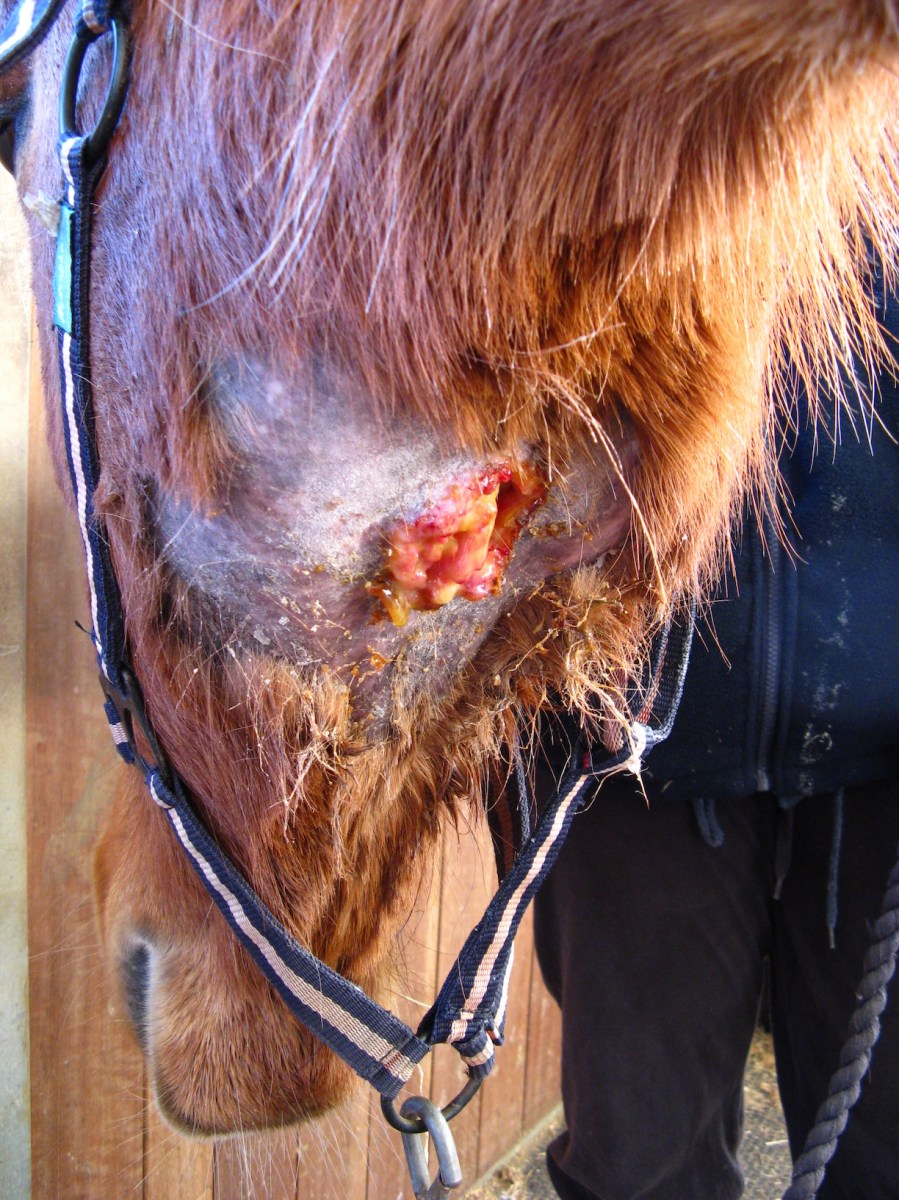
A bad case of strangles. Credit: Royal (Dick) School of Veterinary Studies
Because clinical signs can vary, it is important to immediately isolate any horse as soon as a strangles infection is suspected.
You should then immediately call out a vet to examine them and take samples. This is the best way to rapidly work out if there is anything to be concerned about.
In the very early stages of strangles in horses, there aren’t many tests we can do.
To find the bacterium we ideally need samples of pus once the abscesses have ruptured.
Before this, it can be difficult to take samples that will contain the bacterium and it takes time for the horse’s immunity to build up so that a rise in antibody levels can be measured.
Diagnosing strangles in horses
A diagnosis of strangles in horses is made by:
- Finding the bacterium itself (culture) in the sample;
- Finding DNA from the bacterium, which means they were in the sample (qPCR);
- Looking at whether the horse’s immune system developed antibodies to the infection via blood tests.
Scoping can be done when the infection reaches the stage where the bacterium gets discharged into the guttural pouches from a burst abscess in a lymph node in the throat area.
Scoping is an equine endoscopy, where a camera is passed through the nose to view a horse’s internal organs.
Abscesses in the throat area give rise to the snotty nose we see in many (but not all) cases of strangles in horses.
It is possible for the infection to be limited to just the glands of the throat, which leads to snotty noses or an abscess opening up near the ear.
Alternatively, the infection sits in the glands between the two halves of the lower jaw.
Testing for strangles
Blood testing for a strangles infection is a big topic of conversation. This is a very useful test if you take time to understand what the results mean.
Confirming strangles as the cause of disease in horses isn’t always straightforward, as the bacterium doesn’t grow readily once outside the horse, so repeated samples may be necessary.
Of course, this means that the costs to the owner can be significant, meaning a single blood test appeals greatly.
However, there is always a catch! This blood test purely reflects whether a horse has antibodies to the bacterium (or not).
A positive result does not tell you whether the horse has an active strangles infection. Horses with active infection may well have a positive result. However, in the early stages of infection it is likely to be negative.
So, what do the results mean?
A negative result shows that the horse does not have significant antibodies against the strangles bacterium. It takes around two weeks for antibodies to develop, which explains why horses that are in the first two weeks of infection will have a negative blood result, despite being infected.
Antibodies to strangles
Likewise, antibodies will hang around in the horse’s body for several months, if not years after infection has resolved.
Antibodies can also form without the horse being infected by strangles itself, but merely by being in contact with other horses who have the disease.
This explains why some horses on a yard where there is an active outbreak don’t have the disease themselves yet they return a positive result — further complicating the interpretation of results.
In short, blood testing may seem to be a cheaper and more simple alternative to scoping or having repeated nasopharyngeal (this is the upper part of the pharynx, located behind the nose) swabs done.
However, the most appropriate test depends on your horse’s circumstances and what you are trying to achieve.
Prior to moving to a new yard, taking bloods may be the most appropriate test choice. However, scoping a horse is the fastest and most reliable way of confirming presence of strangles.
Helping a horse with strangles
At first suspicion of any of the signs of strangles in horses, the affected horse should be isolated.
Regular temperature checking is the best defence to spreading the disease to any other horses. If a quarantine area is not available, then every stable or paddock can be set up to become a quarantine that would be effective for strangles.
On yards with more than one horse, horses should be divided into three groups which do not mix in a traffic light system:
-
-
- Red group: horses with clinical signs of strangles or a raised temperature.
- Orange group: horses who were in contact with horses from the red group, even if it was only indirect (sharing water troughs etc).
- Green group: no known contact with horses in either the red or orange group.
-
Always try to have separate people care for the different colour groups. If this isn’t possible, start with the green group and then move to amber before looking after the red group. If red group horses are in need of additional nursing, then separate people should care for these horses and they should be very careful if they are also responsible for green or amber horses.
Stopping the spread
- People coming into contact with any horses in the red and amber groups should use overalls or plastic aprons, gloves and separate wellies or overshoes that are worn only when around this group.
- All of these items should be removed and disinfected or disposed of when leaving the horse or group.
- Regular hand washing and hand sanitiser are important.
- Separate stable equipment should be used for each group of horses too, from forks and brushes to buckets and clippers.
- Open and kind communication is encouraged, so the community can support affected yards and also keep other horses safe from infection.
Financial impact of strangles in horses
Jonathan Cleaver, co-owner of Ivesley Equestrian, openly discusses the impact of the strangles outbreak on his yard in a conversation with Abigail Turnbull, co-owner of Richmond Equestrian Centre in Yorkshire.
They cover everything from business operations to the wellbeing of their equine community, plus the challenges faced during an outbreak and some of the lessons learned along the way in this video:
Strangles Awareness Week
The global collaboration behind Strangles Awareness Week (SAW) has launched the latest practical guidance to offer the BEST protection against strangles:
- Boost immunity by vaccinating against strangles
- Educate yourself and others
- Separate new horses
- Temperature check routinely
Understanding basic biosecurity principles is important for every horse owner to minimise the chance of contracting and spreading disease, and maximising their horse’s health.
As part of Strangles Awareness Week, owners, yard managers and vets are able to learn more about strangles in horses and prevention and then incorporate this into their daily routines.
Speaking to your own vet about testing for strangles is really important.
You can see why this topic takes so much time out of my day and represents such a challenge.
It’s a good job I can talk the hind leg off a donkey!

